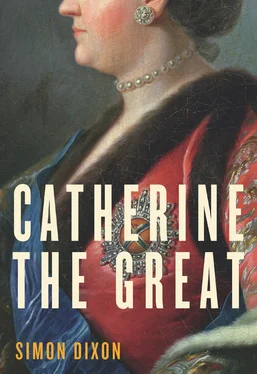Grot and Klyuchevsky were both mistaken. Unfortunately for those who sought to sanitise Catherine’s image, it proved impossible to focus solely on her glorious achievements. On the contrary, a campaign designed primarily to drape Catherine in the Russian flag served rather to enliven interest in her personality. Biographers, in particular, found it hard to detach her patriotic ‘virtues’ from her chequered morals. The liberal journalist Vasily Bilbasov managed to complete only the first part of a projected twelve-volume work before running into trouble with the censors. They objected to his quotations from Catherine’s memoirs, to a reference to her illegitimate son, Aleksey Bobrinsky, and to his discussion of the vexed question of Tsar Paul’s paternity. The book was published thanks to the intervention of Alexander III, who insisted on raising the price to a prohibitive five roubles, but the censors had the last laugh when the tsar discovered that Bilbasov was the same ‘swine’ who edited the liberal newspaper The Voice . 82Bilbasov’s second volume had to be published in Berlin. Russians nevertheless found ways of reading it, and the demand for titillating information about Catherine never abated.
In 1897, the teenage poet Alexander Blok declared that Catherine was his favourite heroine in history on a visit to Bad Neuheim during which, by a delicious coincidence, he lost his virginity to a woman more than twice his age, described by his biographer as ‘his type: big, spontaneous, and talented rather than intellectual’. 83Though it was only after the revolution of 1905 that salacious stories of the empress’s ‘intimate life’ could be published in Russia, Catherine’s admirers found their own way of celebrating her memory. 84Thanks to the patronage of Grand Duke Nikolay Mikhaylovich, a circle of antiquarians including the snuffbox connoisseur S. N. Kaznakov, and Grigory Orlov’s biographer, Alexander Golombiyevsky, staged an exhibition of imperial portraits at the Tauride Palace in spring 1905. Between February and May, undeterred by revolutionary unrest, some 45,000 visitors marvelled at forty-four paintings of Catherine, displayed alongside thirty-five of Peter the Great and Alexander I in the palace she had built for Potëmkin. (Shortly afterwards the great colonnade where he had entertained her in April 1791 became the outer hall of Russia’s first national representative assembly, the State Duma.) 85The exhibition’s guiding force was Sergey Dyaghilev, whose collaborators in the predominantly homosexual ‘World of Art’ group experienced their own scandalous frisson by gathering in 1906 to examine what they believed to be a wax model of Potëmkin’s phallus, allegedly commissioned by Catherine ‘for the edification of diminished successors’, and smuggled out of the Hermitage by a curator at the behest of his son, the erotic artist Konstantin Somov.
One reason why the empress continued to have such a profound resonance at the beginning of the twentieth century was the presence at the Court of St Petersburg, throughout the reigns of the last two tsars, of a woman who deliberately modelled herself on Catherine the Great. This was the grand duchess Maria Pavlovna, wife of Alexander III’s brother, Grand Duke Vladimir Aleksandrovich, born Princess Marie of Mecklenburg-Schwerin. Gossips claimed that this ‘debauched German’ led a ‘dissolute life’ by holding ‘small orgies’ at her residence along the embankment from the Winter Palace. A scandal at the Cubat Frères restaurant in 1889 prompted rumours that she would be forced to emigrate. 86Shortly afterwards, the customarily humourless Alexander III joked at a fisheries trade fair that a stand featuring semi-naked peasant women dressed as mermaids might inspire Maria Pavlovna’s next costumed ball. 87Recalling Catherine’s own mistreatment under Elizabeth and Peter III, friends of the grand duchess attributed such sniping to envy of her intelligence and beauty. 88To her critics, however, she personified the reasons why Catherine’s reign symbolised not the golden age of the Romanov dynasty, but rather, to quote Richard Wortman, its ‘reprehensible past’ in which the empress herself, ‘possessed by ambition, flagrant in her inconstancy and indifference to the family, seemed threatening to the very notion of nineteenth-century legitimacy’. 89The British ambassador Sir George Buchanan outlined the more attractive characteristics that raised echoes of Catherine the Great:
A grande dame in the best sense of that term, but without any pretensions as regards the strict observation of Court etiquette, the Grand Duchess was admirably fitted to play the part of the hostess and to do the honours of the Court. With great conversational gifts, she was not only herself full of verve and entrain, but possessed the art of inspiring them in others. Her entertainments, no matter what form they took, were never dull, and no one was ever bored. At her dinners and receptions one met many of the younger members of the Imperial family and the elite of Russian society, more especially the ‘smart set’, as well as a sprinkling of the official and artistic worlds. 90
While an uninterrupted male line of succession in Prussia permitted successive Hohenzollerns to draw inspiration from the heroic image of Frederick the Great—as, indeed, did Bismarck, Hitler and Goebbels—no nineteenth-century Romanov tsar could comfortably model himself on Catherine. Major General Sir John Hanbury Williams thought he could still detect in 1914 the shadows of that ‘halo of mystery’ attaching to the days when Catherine addressed letters to his ancestor Sir Charles ‘as “Madame” and he to her as “Monsieur”’. But the more historians emphasised Catherine’s contribution to Russia’s great power status, the less likely her latest successor seemed to be able to sustain it. One need only recall Hanbury Williams’ doleful comment after an interview with the tsar at his Mogilëv headquarters in October 1915: ‘Catherine was a wonderful ruler of Russia, but these are not the days of Catherine.’ 91
* * *
‘True glory cannot be sought,’ General Suvorov reminded Admiral Ribas in November 1790, ‘it comes from the sacrifice that one makes to the utility of the public good.’ 92Catherine was aware of the tension. Regularly reaffirming her commitment to the common good, she was nevertheless obsessed with her own posthumous reputation. It would have delighted her to know that, after her death, Academician Peter Pallas re-christened one of the steppe grasses he had discovered ‘ Catharinaea sublimis ’. 93‘She loves glory and is assiduous in her pursuit of it,’ Prince Shcherbatov wrote in 1786–7. 94Those were years in which she embarked on a major renovation of the road from St Petersburg to Moscow, recommended to her by Diderot in 1773 as a good way of securing immortality. This, indeed, was one subject on which Catherine was particularly anxious to assure the approbation of the philosophes . 95She offered her own self-assessment to Grimm in 1778:
Here lies Catherine the Second, born at Stettin on 21 April 1729. She came to Russia in 1744 to marry Peter III. At the age of fourteen, she conceived the triple ambition of pleasing her husband, Elizabeth and the nation. She overlooked nothing to achieve this. In eighteen years of boredom and solitude she read many books. Once she had reached the throne of Russia, she wanted only good and sought to procure happiness, freedom and property for her subjects. She forgave with ease and hated no one; indulgent, happy to be alive, cheerful by nature, with a republican soul and a good heart, she had friends; work was easy for her, company and the arts pleased her. 96
That was not how contemporary critics saw her. Shcherbatov complained in a treatise written only for the eyes of his family that ‘true friendship never resided in her heart, and she is ready to betray her best friend and servant in order to please her lover’. According to him, the empress’s obsessive quest for immortality had left her vulnerable to a series of cunning flatterers—Betskoy, Yelagin, Vyazemsky and Bezborodko prominent among them. Too many of her projects, founded ostensibly ‘for the good of the nation’ were in fact ‘simply symbols of her love of glory, for if she really had the nation’s interest at heart, she would, after founding them, have also paid attention to their progress’. This was the voice of a scholarly aristocrat who had once enjoyed Catherine’s patronage as an historian but now found himself permanently excluded from her inner circle. Although she had always tried to balance one adviser against another, never allowing anyone to think that his ideas had no prospect of being accepted, this proved an increasingly difficult balance to hold. To those outside her charmed circle, Potëmkin had come to epitomise the corrupting influence of favouritism in the last decade of her reign: ‘love of power, ostentation, pandering to all his desires, gluttony and hence luxury at table, flattery, avarice, rapaciousness, and it may be said, all the other vices known in the world, with which he himself is full and with which he fills his supporters, and so on throughout the empire’. 97
Читать дальше












